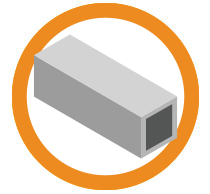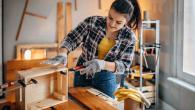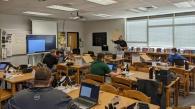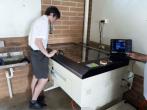
Science Fiction is rapidly becoming Science Fact, thanks in part to those technical wizards in the space industry.
We have all benefited from the spoils of the decades-long space race, because of the incredibly useful products and procedures it has spawned.
Many familiar products can be either directly or indirectly contributed to space technology research and development, such as:
- Camera phones
- Portable computers
- Computer mouse
- Precision GPS
- CAT scans
- High power solar cells
- Wireless headsets
- UV-Blocking sunglasses
- LED lighting, home insulation
- Portable cordless vacuums
- Freeze-dried foods
- Foil blankets
- Memory foam
- Ear thermometers
- Pool water purification systems
- Scratch-resistant eyeglass lenses
- Nike Air sneakers
- The HACCP rating system for food safety (visit here for a deep dive into the exciting world of safety classifications)
3D Printing in Space
Now the modern marvel that is the 3D Printer is increasingly finding its way into space exploration.
3D printing as a manufacturing method has developed spectacularly over the past decade. NASA, the European Space Agency (ESA), and the space agencies of Russia, China, and India are all figuratively and literally over the moon about the potential of 3D printers. Not only have they embraced existing technologies (there are 3D printed parts currently on Mars), they are actively working to take additive manufacturing to the next level.
Additive manufacturing is the fancy way of saying 3D Printing, and it is a way of printing three-dimensional (3D) components from a digital model.
Instead of forging, moulding, or cutting materials, 3D printing relies on melting material in successive layers to give shape to something. Doing so allows engineers to play with unique designs and traits, such as making hardware lighter, stronger, or more responsive to heat or cold.
The ability to 3D print parts and tools on demand will dramatically reduce the time and costs it takes to get parts to orbit. Thereby increasing the reliability and safety of space missions.
Currently, space missions take months to years to get parts to orbit. With 3D printing, parts can be built within minutes to hours.
Rocket engines are a particular focus and 3D printed parts are already playing key roles in virtually every new satellite launch. Both SpaceX and Boeing, for example, have literally hundreds of 3D printed components in their new manned capsules.
Everything from parts, to food and even human organs, have the potential to be 3D printed.
Human Organs - made in Space
There is a global shortage of organs suitable for transplant into critically ill patients, some researchers are looking at 3D printing of living tissue as a solution. As it turns out, the micro-gravity of space is the perfect environment.
In fact, the International Space Station (ISS) which is currently orbiting Earth, is the ideal place to conduct these experiments. This is because 3D-printing a tissue culture under the gravity of Earth, can cause them to collapse. But you don't have those effects in a micro-gravity environment of space.
Space Food
Space food is renowned for its sloppy mundanity, but new 3D printing technology is slowly revolutionising the way astronauts will eat.
Food replication was once a figment of the imagination, which materialised from the Star Trek writers’ room. They conceived of a machine that was capable of rapidly producing the finest cordon bleu meal seemingly out of thin air.
This fantastical contraption, born from the imagination, is now quickly evolving into an actual product with real life applications.
The first astronauts once squeezed their imitations of Roasts and Pastas from toothpaste-like tubes. Today’s astronauts enjoy a more extensive variety of food. However, there is the constant issue of food needing to last for extended periods of time, so tech companies are experimenting with ways to grow food onboard a spacecraft.
For example, Aleph Farms, a food-tech startup that has used 3D printer technology to grow meat in space. The company experimented on a Russian Soyuz MS-15 spacecraft orbiting about 250 miles away from Earth.
Aleph Farms created vials of broth developed from cow cells, which Cosmonauts inserted into a magnetic printer from the Russian company 3D Bioprinting Solutions. The printer then replicated those cells to produce muscle tissue - the “meat”.
Although nobody was actually game enough to eat the resulting delicacy, it was a proof of concept, which will probably start a new Space Food Race.
The experiment shows that meat could be grown anywhere on Earth too. Which suggests that companies could print meat in extreme environments, particularly in places where water or land is scarce.
What is the future of 3D Printing?
No matter how sophisticated 3D printers seem now, they are just in their infancy. They are going to get bigger, better and faster.
Today’s students have the unique opportunity of mastering this emerging technology. And, Tools for Schools are here, with the perfect range of 3D printers, to aid them on their technological journey. Check out our range here.
The above is just the tip of the 3D Printing innovation iceberg. Who knows what everyday items will evolve from them in the coming years? What do your students think?







